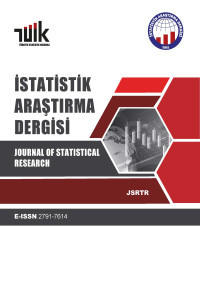Tekrar Satılabilir Ürünler için Gazeteci Çocuk Probleminin Çelişen Amaçlar Altında İncelenmesi
Alternatif amaç fonksiyonları, Beklenen karı aşma olasılığı, Envanter, Gazeteci çocuk problemi, İade ürünler
The Newsvendor Problem for Resalable Products with Conflicting Objectives
Alternative objective functions, Probability of exceeding expected profit, Inventory, Newsvendor problem, Return products,
___
- Chankong, V., Haimes, Y.Y., 1983. Multiple objective decision making. North Holland, New York.
- Coplan, E.H., 1968. Bahavioral assumptions of management accounting. The Accounting Review, 43 (4), 342-362.
- Hillier, F.S., Lieberman, G.J., 1995. Introduction to operations research (6th ed.). McGraw- Hill, NY.
- Kabak, I., Schiff, A., 1978. Inventory models and management objectives. Sloan Management Review, 19 (2), 53-59.
- Khouja, M., 1999. The single-period (news-vendor) problem: Literature review and suggestions for future research. Omega, 27, 537-553.
- Kodama, M., 1995. Probabilistic single period inventory model with partial returns and additional orders. Computers and Industrial Engineering, 29, 455-459.
- Lanzillotti, R.F., 1958. Pricing objectives in large companies. American Economic Review, 48, 921-940.
- Lau, H.S., 1980. The newsboy problem under alternative optimization objectives. Journal of the Operational Research Society, 31, 525-53.
- Lau, A.H.L., Lau, H.S., 1988. Maximizing the probability of achieving a target profit in two-product newsboy problem. Decision Sciences, 19, 392-408.
- Lee C. H., 2001. Coordinated stocking, clearance sales, and return policies for supply chain. European Journal of Opeartions Research, 131, 491-513.
- Li, J., Lau, H., Lau, A.H., 1991. A two-product newsboy problem with satisfying objective and independent exponential demands. IIE Trans, 23, 29-39.
- Mostard, J., Teunter, R., 2006. The newsboy problem with resalable returns: A single period model and case study. European Journal of Operational Research, 169, 81-96
- Parlar, M., Weng, Z.K., 2003. Balancing desirable but conflicting objectives in the newswendor problem. IIE Transactions, 35, 131-142.
- Schiff, M., Lewin, A. Y., 1970. The impact of people on budgets. Accounting Review, 45, 259-268.
- Vlachos, D., Dekker, R., 2002. Return handling options and order quantities for single period products. European Journal of Operational Research, 151, (1), 38-52.
- Wells, M.C., 1968. Professor Machlup and theories of the firm. Economic Record,. 22, 357-368.
- Williamson, O.E., 1970. Corporate control and business behavior. Prentice-Hall, Englewood Cliffs, NJ.
- Winston, W.L., 2004. Operations research. Duxbury, NY.
- Zeleny, M., 1982. Multiple criteria decision making. McGraw-Hill. New York, NY.
- ISSN: 1303-6319
- Başlangıç: 2002
- Yayıncı: TÜİK
Tek Değişkenli Zaman Serilerinde Model Seçim Ölçütleri Üzerine Bir İnceleme
Malmquist Endeksi ile 25 Ülkenin Ortaöğretim Performansının Değerlendirilmesi
Kümeleme Çözümlemesinde Düzeltilmiş Tek Adım M-Tahmin Edicisinin Kullanılması
Abdullah Fırat ÖZDEMİR, Engin YILDIZTEPE
Değişim Katsayılarının Eşitliğine İlişkin Testlerin I.Tip Hata ve Güç Bakımından Karşılaştırılması
Kapsamlı Bir İçerikle Ön Dağılım Türleri
Türk Reel Sektörü için Karşılaştırmalı Etkinlik Ölçümü: Veri Zarflama Analizi Uygulaması
Tekrar Satılabilir Ürünler için Gazeteci Çocuk Probleminin Çelişen Amaçlar Altında İncelenmesi
Umay UZUNOĞLU KOÇER, Mutlu KARA
Türkiye’de Enflasyon Katılığının Araştırılması: Parametrik Olmayan Bir Yaklaşım
Saygın ŞAHİNÖZ, Bedriye SARAÇOĞLU
Biyokimyasal Reaksiyonlar için Stokastik Simülasyon Algoritmalarına Genel Bir Bakış
